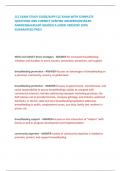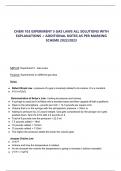CLC EXAM STUDY GUIDE/ALPP CLC EXAM WITH COMPLETE
QUESTIONS AND CORRECT VERIFIED ANSWERS(DETAILED
ANSWERS)ALREADY GRADED A+/NEW VERSION! 100%
GUARANTEED PASS!
WHO and UNICEF three strategies - ANSWER-for increased breastfeeding
initiation and duration in every country: promotion, protection, and support
breastfeeding promotion - ANSWER-focuses on advantages of breastfeeding on
a personal, community, country, or global level
breastfeeding protection - ANSWER-focuses on government, manufacturer, and
social responsibility to assure breastfeeding's ability to compete with
commercial interests; includes addressing improper marketing practices; the
AAP advices not to provide formula, company gift bags, and industry-authored
handouts; in the US, state and local breastfeeding legislation addresses
breastfeeding in public, employment issues, jury duty, family law, mothers in
prison, etc.
breastfeeding support - ANSWER-focuses on the interaction of "helpers" with
family as well as program development and implementation
community expertise - ANSWER-variety of community expertise is needed to
promote, protect, and support breastfeeding
,International models - ANSWER-for integrating breastfeeding promotion,
protection, and support as well as balancing technical information, programs,
and protocols
CLC - ANSWER-nationally recognized designation awarded by the ALPP to those
who are exam eligible and pass the exam; have competenct verified
CLCs and IBCLCs - ANSWER-health professionals who provide lactation support
why is breastfeeding so difficult? - ANSWER-1. unrealistic expectations
2. lack of timely interventions
breast feeding: a public health priority - ANSWER-has been recognized as a
public health priority in tropical climates since the 1930's, but not until the
1990's in the US
costs to prevent needless deaths - ANSWER-less than $6 billion/year worldwide
suboptimal breastfeeding - ANSWER-accounts for more than 3,340 maternal
and child deaths a year, 80% are maternal
nursing a baby for a year or more - ANSWER-decreases by 10-15% the risk of
developing hypertension, diabetes, hyperlipidemia, and cardiovascular disease
women who do not breastfeed - ANSWER-are at greater risk for myocardial
infarction and aspects of metabolic syndrome; are at a greater risk of breast,
endometrial, and ovarian cancer
unrealistic expectations - ANSWER-lack of preparation for what the newborn
period would look like
,lack of timely interventions - ANSWER-mother's problems at 3 to 7 days posed
as the greatest risk to stopping
breastfeeding trends - ANSWER-last 150 years or som rates have declined
international code of matketing of breastmilk substitutes (the code) - ANSWER-
an international health policy framework to regulate the marketing of
breastmilk substitutes in order to protect breastfeeding
- published by the WHO in 1981
- internationally agreed voluntary code of practice
- written in response to the marketing activities of the infant feeding indurstry
which were promoting formula feeding over breastfeeding, which in turn was
leading to dramatic increases in maternal and infant morbidity and mortality
- subsequent clarifying and extending resolutions have been passed by the
world health assembly
the code - ANSWER-regulates the marketing of breastmilk substitutes which
includes infant formulas, follow-on formulas, and any other food or drink,
together with feeding bottles and teats, intended for babies and young
children; sets standards for the labeling and quality of products and for how
the law should be implemented and monitored within countries
restricting marketing - ANSWER-does not mean that the products cannot be
made available, neither does it restrict parents choice; it simply aims to make
sure that their choices are made based on full, impartial information, rather
than misleading, inaccurate, or biased marketing claims
the strategy - ANSWER-is intended as a guide for action
- it identifies interventions with a proven positive impact
, - it emphasizes providing mothers and families the support they need to carry
out their crucial roles
- it explicitly defines the obligations and responsibilities in this regard of
governments, international organizations, and other concerned parties
the world breastfeeding trends initiative - ANSWER-intended to track, assess,
and monitor the implementation of the "global strategy" at the country and
sub-country level
what contributes to low rates of ebf globally? - ANSWER-- caregiver and
societal beliefs favoring mixed feeding
-hospital and healthcare practices and policies that are not supportive of BF
- lack of adequate skills and support
- aggressive promotion of infant formula and other breastmilk substitutes
- inadequate maternity/paternity leave legislation
- workplace policies
- lack of knowledge about dangers of not exclusively BF and proper BF
techniques
how to support ebf - ANSWER-increase hospital and health system capacity
regarding baby friendly hospital initiative
-provide community based strategies including campaigns tailored to local
context
-strengthen monitoring and enforcement of the code
-enact at least 6 months paid maternity leave
-invest in training and capacity building in protection, promotion, support
disparity of US breastfeeding trends - ANSWER-according to the CDC, "black
mothers are less likely than white to breast-feed their babies, and here's one






